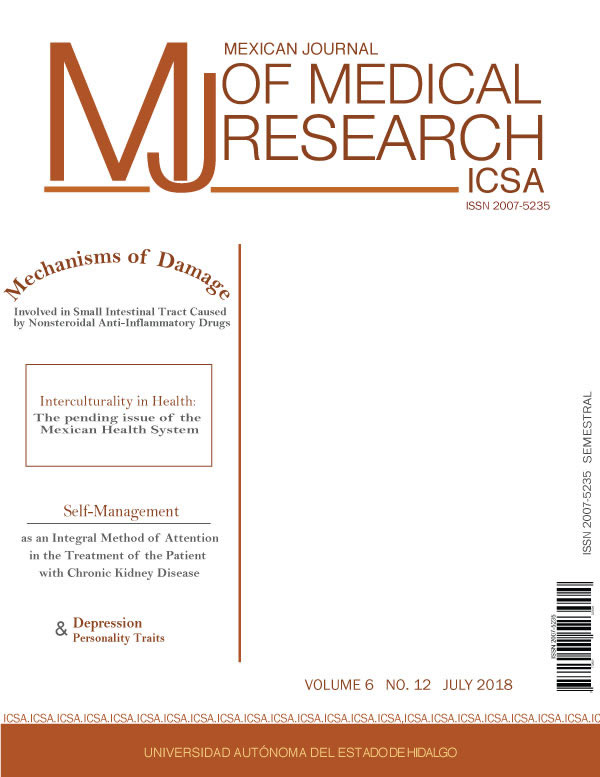Mechanisms of Damage Involved in Small Intestinal Tract Caused by Nonsteroidal Anti-Inflammatory Drugs
DOI:
https://doi.org/10.29057/mjmr.v6i12.3162Keywords:
NSAIDs, intestinal damage, prostaglandin, oxidative stressAbstract
Nonsteroidal anti-inflammatory drugs (NSAIDs) are among the most commonly used type of drugs, as they are very effective as antiinflammatory,
anti-pyretic and analgesic. Their use has increased dramatically over the years even without a medical
prescription¸however the use of NSAIDs is limited due to the adverse effect in the gastrointestinal tract, heart and kidney. This
research work is focused on the adverse effect in the gastrointestinal tract. The mechanisms involved in gastric damage caused by
NSAIDs are well known compared to those in the intestinal area. Research on NSAID-induced intestinal damage is very limited,
despite its higher mortality rate, partially due to the difficulty of reaching this area. Therefore, this review mentions some of the
mechanisms involved in small intestinal damage to help as a reference to continue doing research about new strategies to come up
with an effective clinical therapy.
Downloads
Publication Facts
Reviewer profiles N/A
Author statements
- Academic society
- N/A
- Publisher
- Universidad Autónoma del Estado de Hidalgo
References
Artis D. Epithelial-cell recognition of commensal bacteria and maintenance of immune homeostasis in the gut. Nat. Rev. Immunol. 2008; 8:411-20.
Pluske J. Gastrointestinal tract barrier function. School of Veterinary and Life Sciences, Murdoch University, Australia. Taken from the web on march 05 2018: https://www.dsm.com/content/dam/dsm/anh/en_US/documents/GIT_Barrier_Function_JP.pdf
Turner, J. Intestinal mucosal barrier function in health and disease. Nat. Rev. Immunol. 2009; 9:799-809.
Rescigno M. The intestinal epithelial barrier in the control of homeostasis and immunity. Trends Immunol. 2011; 32:256-64.
Wolfe MM, Lightenstein DR, Singh G. Gastrointestinal Toxicity of Nonsteroidal Anti-inflammatory Drugs. N. Engl. J. Med. 1999; 340: 1888-1899.
Raña-Garibay R, de los Ángeles Villanueva-Carreto M, Avendaño-Reyes JM, Nogueira de Rojas JR, Jiménez Córdoba RR. Guías clínicas de diagnóstico y tratamiento de la enfermedad por úlcera péptica. Rev. Gastroenterol. Mex. 2009; 74(2):144-148.
Frisancho Velarde O. Gastropatías por antinflamatorios no esteroideos. Bol de la Sociedad Peruana de Med Inter 1997; 10(3).
Quintero Carrióna E. Efectos de los AINEs sobre la mucosa gastrointestinal. Rev. Esp. Reuma. 2000; 27(1):19-24.
Everhart JE, Ruhl CE. Burden of digestive diseases in the United States. Gastroenterology 2009; 136:376-386.
Huerta-Iga FM. Hemorragia de tubo digestivo proximal no variceal: evaluación inicial y tratamiento médico. In: Dra. María Victoria Bielsa Fernández, Dr. Ricardo Raña Garibay, Dr. José Luis Tamayo de la Cuesta editors. Gastrotrilogía II Urgencias en Gastroenterología. 2016; 30-37.
Syer SD, Wallace JL. Environmental and NSAID-Enteropathy: Dysbiosis as a common factor. Curr. Gastroenterol. Rep. 2014; 16:377.
Bjarnason I, Scarpignato C., Holmgren E, Olszewski M, Rainsford KD, Lanas A. Mechanisms of damage to the gastrointestinal tract from non-steroidal anti-inflammatory drugs. Gastroenterology 2018; 153 (3): 500-514.
Wallace JL, Syer S, Denou E, De Palma G, Vong L, McKnight W, Jury J, Bolla M, Bernick P, Collins SM, Verdu E, Onigini E. Proton Pump Inhibitors Exacerbate NSAID-Induced Small Intestinal Injury by Inducing Dysbiosis. Gastroenterology 2011; 141:1314-1322.
Wallace JL. NSAID gastropathy and enteropathy: distinct pathogenesis likely necessitates distinct prevention strategies. Br. J. Pharmacol. 2012. 165(1). 67-74.
Weingberg M, Froum FJ. Fármacos en Odontología: Guía de prescripción. Editorial El Manual Moderno S.A. de C.V. 2014.
Lorenzo P, Moreno A, Lizasoain I, Leza JC, Moro MA, and Portolés A. Farmacología Básica y Clínica / Velázquez. 18 Ed. Médica Panamericana. Madrid. 2009.
Salazar-Vallejo M, Peralta Rodrigo C, Pastor Ruiz FJ. Tratado de Psicofarmacología: bases y aplicaciones clínicas. 2nd Edition. Médica Panamericana. Buenos Aires. 2009.
Mendoza Patiño N. Farmacología medica / Medical Pharmacology. Editorial Médica Panamericana. UNAM, Facultad de Medicina. México. 2008.
Wallace JL. Nonsteroidal anti-inflammatory drugs and gastroenteropathy: The second hundred years. Gastroenterology 1997; 112:1000-1016.
Boelsterli UA, Redinbo MR, Saitta KS. Multiple NSAID-induced hits injure the small intestine: underlying mechanisms and novel strategies. Toxicol. Sci. 2012; 131(2): 654-667.
Betteridge DJ. What is oxidative stress? Metabolism 2000; 49(2):3-8.
Gagné F. Oxidative Stress. In: Biochemical Ecotoxicology: Principles and methods. Elsevier 2014: 103-115.
Kono Y, Kawano S, Takaki A, Shimomura Y, Onji M, Ishikawa H, Takahashi S, Horii J, Kobayashi S, Kawai D, Yamamoto K, Okada H. Oxidative stress controlling agents are effective for small intestinal injuries induced by non-steroidal anti-inflammatory drugs. J Gastroenterol. Hepatol. 2017; 32(1):136-145.
Fujimori S, Gudis K, Takahashi Y, Seo T, Yamada Y, Ehara A, Kobayashi T, Mitsui K, Yonezawa M, Tanaka S, Tatsugushi A, Sakamoto C. Distribution of small intestinal mucosal injuries as a result of NSAID administration. Eur. J. Clin. Invest. 2010;40(6): 504-510.
Bjornsson E, Westgaard G, Bjarnason I. Severe injury to the small bowel associated with a short course of diclofenac. Scand. J. Gastroenterol. 2008; 43:759-760.
Otani K, Tanigawa T, Watanabe T, Shimada S, Nadatani Y, Shiba M, Tominaga K, Fujiwara Y, Arakawa T. Microbiota plays a key role in Non-steroidal anti-inflammatory drug-induced small intestinal damage. Digestion 2017; 95:22-28.
Graham DY, Opekun AR, Willingham FF, Qureshi WA. Visible small intestinal mucosal injury in chronic NSAID users. Clin. Gastroenterol. Hepatol. 2005; 3:55-59.
Maiden L, Thjodleifsson B, Theodors A, Gonzalez J, Bjarnason I. A quantitative analysis of NSAID-induced small bowel pathology by capsule endoscopy. Gastroenterology 2005;128(5):1171-1178.
Bjarnason I, Takeuchi K. Intestinal permeability in the pathogenesis of NSAID-induced enteropathy. J. Gastroenterol. 2009;44(19):23-29.
Gadelle D, Raibaud P, Sacquet E. Beta-glucuronidase activities of intestinal bacteria determined both in vitro and in vivo in gnotobiotic rats. Appl. Environ. Microbiol. 1985; 49:682-685.
LoGuidice A, Wallace BD, Bendel L, Redinbo MR, Boelsterli UA. Pharmacologic targeting of bacterial b-glucuronidase alleviates nonsteroidal anti-inflammatory drug-induced enteropathy in mice. J. Pharmacol. Exp. Ther. 2012; 341:447-454.
Wallace JL. Mechanisms, prevention and clinical implications of nonsteroidal anti-inflammatory drug-induced enteropathy. World. J. Gastroenterol. 2013;19(12): 1861-1876.
Endo H, Higurashi T, Hosono K, Sakai E, Sekino Y, Lida H, et al. Efficacy of lactobacillus casei treatment on small bowel injury in chronic low-dose aspirin users: a pilot randomized controlled study. J. Gastroenterol. 2011; 46:894–905.
Aditortey MB, Ansah C, Galynuon I, Nyarko A. In vivo models used for evaluation of potential antigastroduodenal ulcer agents. Ulcers 2013;(2013): 1- 12






















